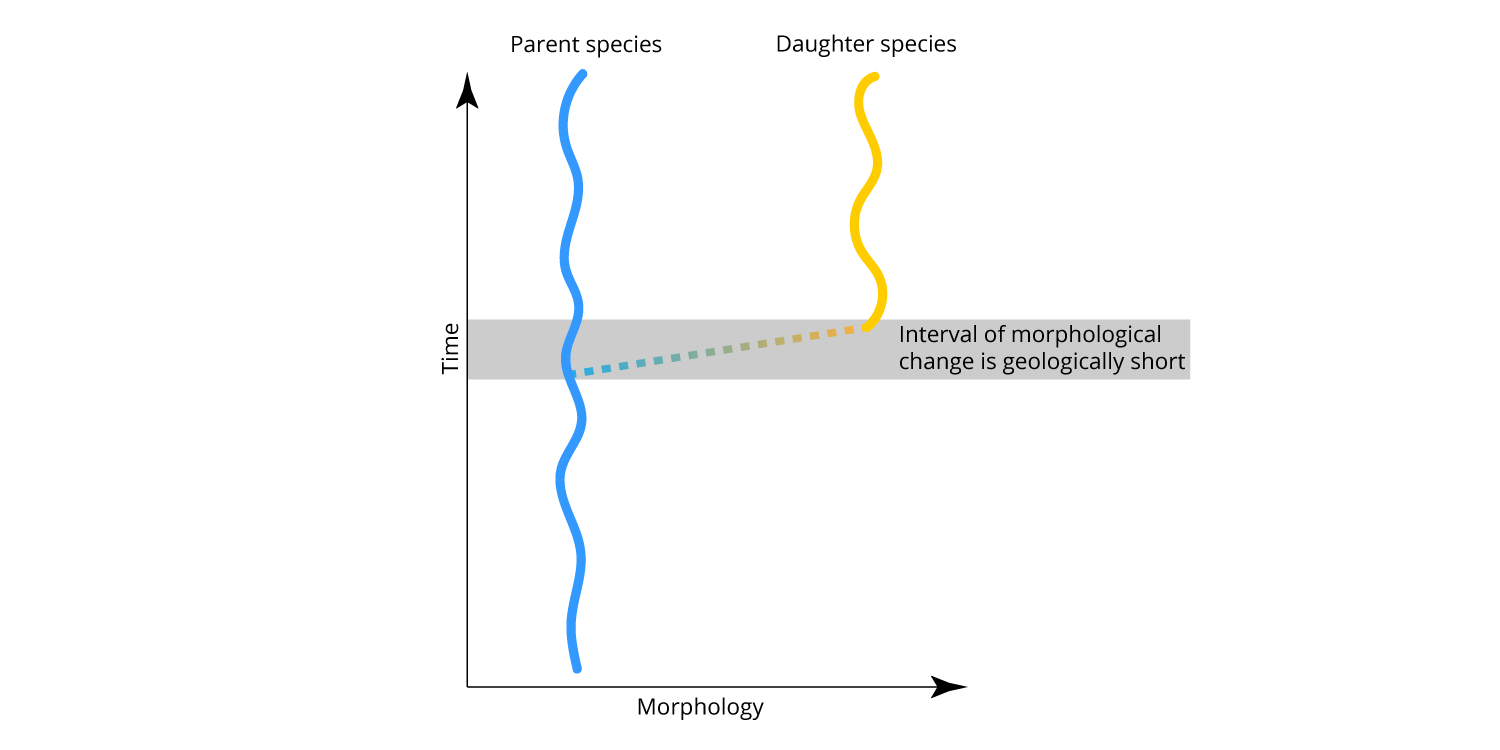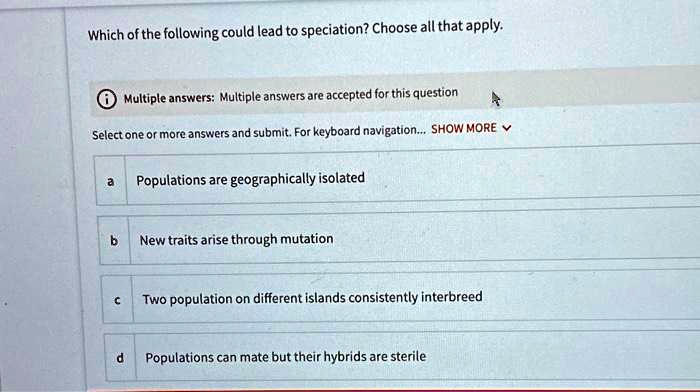Question Which of the following factors would not contribute to allopatric speciation? A) The separated population is small, and genetic drift occurs. B) The isolated population is exposed to different selection pressures than the ancestral population. C) Different mutations begin to distinguish the gene pools of the separated populations.
The skull variation of the olive field mouse Abrothrix olivacea (Cricetidae: Abrotrichini) is localized and correlated to the ecogeographic features of its geographic distribution [PeerJ]
Oct 31, 2023The northern spotted owl has genetic and phenotypic differences from its close relative, the Mexican spotted owl, which lives in the south. Figure 18.2D. 1 18.2 D. 1: Allopatric speciation due to geographic separation: The northern spotted owl and the Mexican spotted owl inhabit geographically separate locations with different climates and

Source Image: quizlet.com
Download Image
Allopatric speciation is speciation that happens when two populations of the same species become isolated from each other due to geographic changes. Speciation is a gradual process by which populations evolve into different species.

Source Image: www.digitalatlasofancientlife.org
Download Image
BIO Chapter 14&1 Homework Flashcards | Quizlet Which of the following contribute to allopatric speciation? geographic and reproductive isolation. Which of the following is often a cause of sympatric speciation? polyploidy. The Bt-cotton is an example of. evolution through genetic modification.

Source Image: www.numerade.com
Download Image
Which Of The Following Would Not Contribute To Allopatric Speciation
Which of the following contribute to allopatric speciation? geographic and reproductive isolation. Which of the following is often a cause of sympatric speciation? polyploidy. The Bt-cotton is an example of. evolution through genetic modification. Allopatric speciation (from Ancient Greek ἄλλος (állos) ‘other’, and πατρίς (patrís) ‘fatherland’) – also referred to as geographic speciation, vicariant speciation, or its earlier name the dumbbell model: 86 – is a mode of speciation that occurs when biological populations become geographically isolated from each other to an extent that prevents or interferes with gene flow.
SOLVED: Which ofthe following could , lead to speciation? Choose all that apply: Multiple answers: Multiple answers are accepted for this question Select one or more answers and submit: For keyboard navigation
Answer: Founder effect Answer: Hybrid Inviability Explanation: Allopatric speciation It is also called geographic speciation and vicariant speciation It isone of the proces … View the full answer Previous question Next question Transcribed image text: Which of the following factors would NOT contribute to allopatric speciation? Which of the following factors would not contribute to allopatric… | Channels for Pearson+

Source Image: www.pearson.com
Download Image
What Is Speciation and How Should We Study It? | The American Naturalist: Vol 163, No 6 Answer: Founder effect Answer: Hybrid Inviability Explanation: Allopatric speciation It is also called geographic speciation and vicariant speciation It isone of the proces … View the full answer Previous question Next question Transcribed image text: Which of the following factors would NOT contribute to allopatric speciation?

Source Image: www.journals.uchicago.edu
Download Image
The skull variation of the olive field mouse Abrothrix olivacea (Cricetidae: Abrotrichini) is localized and correlated to the ecogeographic features of its geographic distribution [PeerJ] Question Which of the following factors would not contribute to allopatric speciation? A) The separated population is small, and genetic drift occurs. B) The isolated population is exposed to different selection pressures than the ancestral population. C) Different mutations begin to distinguish the gene pools of the separated populations.
![The skull variation of the olive field mouse Abrothrix olivacea (Cricetidae: Abrotrichini) is localized and correlated to the ecogeographic features of its geographic distribution [PeerJ]](https://dfzljdn9uc3pi.cloudfront.net/2023/15200/1/fig-2-full.png)
Source Image: peerj.com
Download Image
BIO Chapter 14&1 Homework Flashcards | Quizlet Allopatric speciation is speciation that happens when two populations of the same species become isolated from each other due to geographic changes. Speciation is a gradual process by which populations evolve into different species.

Source Image: quizlet.com
Download Image
All of the following results in speciation except Allopatric speciation. Allopatric speciation is just a fancy name for speciation by geographic isolation, discussed earlier. In this mode of speciation, something extrinsic to the organisms prevents two or more groups from mating with each other regularly, eventually causing that lineage to speciate. Isolation might occur because of great

Source Image: www.toppr.com
Download Image
Speciation and Extinction Doodle Notes Which of the following contribute to allopatric speciation? geographic and reproductive isolation. Which of the following is often a cause of sympatric speciation? polyploidy. The Bt-cotton is an example of. evolution through genetic modification.

Source Image: emmatheteachie.com
Download Image
PPT – Speciation PowerPoint Presentation, free download – ID:2011582 Allopatric speciation (from Ancient Greek ἄλλος (állos) ‘other’, and πατρίς (patrís) ‘fatherland’) – also referred to as geographic speciation, vicariant speciation, or its earlier name the dumbbell model: 86 – is a mode of speciation that occurs when biological populations become geographically isolated from each other to an extent that prevents or interferes with gene flow.

Source Image: www.slideserve.com
Download Image
What Is Speciation and How Should We Study It? | The American Naturalist: Vol 163, No 6
PPT – Speciation PowerPoint Presentation, free download – ID:2011582 Oct 31, 2023The northern spotted owl has genetic and phenotypic differences from its close relative, the Mexican spotted owl, which lives in the south. Figure 18.2D. 1 18.2 D. 1: Allopatric speciation due to geographic separation: The northern spotted owl and the Mexican spotted owl inhabit geographically separate locations with different climates and
BIO Chapter 14&1 Homework Flashcards | Quizlet Speciation and Extinction Doodle Notes Allopatric speciation. Allopatric speciation is just a fancy name for speciation by geographic isolation, discussed earlier. In this mode of speciation, something extrinsic to the organisms prevents two or more groups from mating with each other regularly, eventually causing that lineage to speciate. Isolation might occur because of great